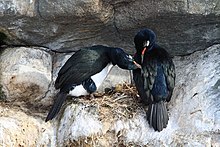Rock shag
| Rock shag | |
|---|---|

| |
| Scientific classification | |
| Kingdom: | |
| Phylum: | |
| Class: | |
| Order: | |
| Family: | |
| Genus: | |
| Species: | P. magellanicus
|
| Binomial name | |
| Phalacrocorax magellanicus (Gmelin, 1789)
| |
The rock shag (Phalacrocorax magellanicus), also known as the Magellanic cormorant, is a marine cormorant found around the southernmost coasts of South America. Its breeding range is from around Valdivia, Chile, south to Cape Horn and Tierra del Fuego, and north to Punta Tombo in Argentina. In winter it is seen further north, with individuals reaching as far as Santiago, Chile on the west coast and Uruguay on the east. The birds also breed around the coasts of the Falkland Islands
At a distance, the rock shag is a black and white bird, with head, neck and upperparts black and chest and underparts white. Closer up, the black areas vary from metallic blue to oily green, and are flecked with white in places. The legs and feet are a pink, fleshy colour, and the bare flesh around the beak and eyes is brick red. In breeding condition, there is a blackish though not very prominent crest on the forehead, and a distinctive white ear patch. There is even less sexual dimorphism than in most cormorant species, but males are 5%-10% larger on most size measurements.

Like all cormorants, the rock shag feeds by diving for underwater prey. It feeds close to shore, often diving at the edge of kelp beds and apparently finding small fish (predominantly cod icefishes, Patagonotothen species) sheltering among the weed. Studies with depth gauges suggest that it is a fairly shallow diver, typically going about 5 m below the surface with few individuals diving deeper than 10 m, although its prey mainly comes from the sea floor. Dive times are typically around 30 seconds. Its breeding range overlaps markedly with that of the imperial shag Leucocarbo atriceps, but the two species' foraging ranges are different since the imperial shag tends to dive in deeper water, further out from shore.
The rock shag usually nests on ledges on steep, bare, rocky cliffs. It normally lays three eggs, though nests of from two to five eggs have been seen. Nesting colonies range is size from five pairs to nearly 400.
Like a number of other species of cormorant that are commonly called shags, the rock shag is placed by some authors in a genus Leucocarbo. Cladistic analysis suggests that it is related to other cliff-nesting species such as the red-legged cormorant, pelagic cormorant and red-faced shag.

References
- Johnsgaard, P. A. (1993). Cormorants, darters and pelicans of the world. Washington DC, Smithsonian Institution Press.
- Punta, G., Yorio, P., & Herrera, G. (2003). Temporal patterns in the diet and food partitioning in imperial cormorants (Phalacrocorax atriceps) and rock shags (P. magellanicus) breeding at Bahia Bustamante, Argentina. Wilson Bulletin, 115, 307-315.
- Sapoznikow, A., & Quintana, F. (2006). Colony attendance pattern of Rock Shags (Phalacrocorax magellanicus): an evidence of the use of predictable and low seasonally food sources? Ornitologia Neotropical, 17, 95-103.
- Wanless, S., & Harris, M. P. (1991). Diving patterns of full-grown and juvenile rock shags. Condor, 93, 44-48.

